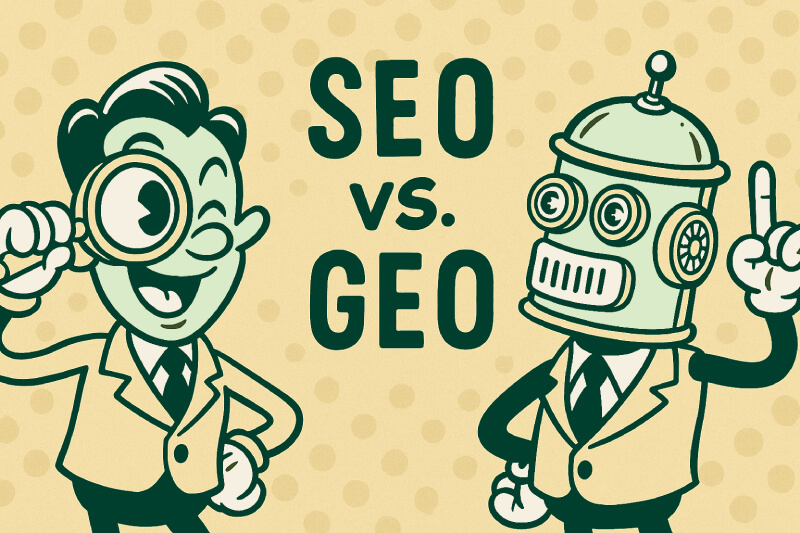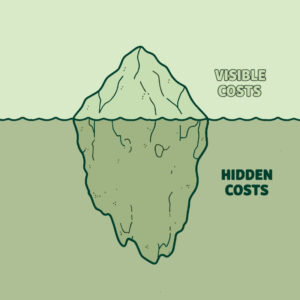.
How SEO and GEO Are Shaping the Future of Search in 2025
Search and user behaviour is changing faster than most realise, and the way people find information no longer looks the same as it did just a few years ago. The familiar experience of scrolling through long lists of blue links is gradually being replaced by richer, AI-powered results. Today, users receive instant, conversational answers from tools such as Google’s AI Mode, Bing Copilot, ChatGPT and Perplexity, which gather information from across the internet and summarise it within seconds.
For businesses, this shift completely redefines what visibility means. Success is no longer only about ranking well on Google; it is about becoming part of the conversation wherever people are searching for answers. At boxChilli, we call this the Search Experience or as others have coined it ‘GEO’ – a way of combining strong traditional SEO practices with intelligent content and thoughtful design so that brands remain discoverable whether someone is reading, scrolling, or speaking to an AI.
Why AI-Driven Search Matters Now
Search has always been the starting point for most customer journeys, but in 2025, that starting point looks very different. Artificial intelligence is reshaping how people explore, evaluate and trust the information they find. The brands that adapt early will stay visible, while those that rely on traditional SEO alone will gradually lose presence in the spaces where decisions are made. To stay visible today, businesses need to understand how visibility itself is evolving.
That is where GEO, or Generative Engine Optimisation, becomes essential. GEO is not about replacing SEO as many other agencies will claim, but it represents the next natural stage of its evolution. It ensures your brand remains visible and credible in a world where AI increasingly decides what users see first. Understanding how these two disciplines connect has now become one of the most valuable skills for marketers in 2025 and beyond.
What Is SEO (Still)?
Even with search changing so rapidly, Search Engine Optimisation remains the foundation of online visibility. It helps search engines understand, index, and display your content so that people can find it when they are looking for something relevant to your business. The discipline continues to evolve, yet its purpose is still the same: to connect valuable, well-presented information with the people who are searching for it.
Good SEO rests on three core pillars that work together to strengthen how your website performs and how clearly it communicates its value.
Technical SEO
Technical SEO focuses on building a strong and reliable foundation for your site. It ensures that pages load quickly, perform smoothly on mobile, and follow a logical structure that search engines can easily crawl and interpret. Clean code, efficient performance, and secure HTTPS connections all contribute to how confidently search engines can surface your content in the right places.
On-Page Optimisation
On-page optimisation is about making your content clear and meaningful. It includes the use of headings, metadata, internal links, and overall site structure, helping search engines understand how each page fits into the bigger picture. When these elements are properly aligned, search engines can match your pages to the most relevant user queries, improving both visibility and user experience.
Authority and Trust
Authority signals to search engines that your content is credible. When trusted websites link to yours or mention your brand, it shows that your insights are reliable and worth sharing. Building this kind of credibility takes time and consistency, but it remains one of the most important factors for achieving sustainable search performance.
SEO continues to be the starting point for every digital visibility strategy because it provides the structure that everything else depends on. Even in an AI-driven world, systems like Google’s AI Overviews and Bing Copilot still rely on high-quality, well-organised content to generate accurate results. Without strong SEO foundations, there is no base for Generative Engine Optimisation to build upon.
What Is Generative Engine Optimisation (GEO)?
Generative Engine Optimisation, often called GEO, is the process of helping artificial intelligence systems recognise, interpret, and reference your content within generative search results. While SEO has traditionally focused on ranking web pages within search results, GEO extends that approach by ensuring that your ideas and insights are represented within the AI-driven search engines.
The term began gaining attention in 2023 when Google introduced its Search Generative Experience (SGE) and platforms such as Bing Copilot, ChatGPT, and Perplexity started reshaping how people searched for and consumed information. Instead of presenting a list of blue links, these systems began creating summaries drawn from a mix of trusted sources. GEO then emerged as a way to help brands increase their chances of being included within those summaries by improving how content is structured, written, and supported with reliable evidence.
At its core, GEO is about clarity and credibility. Artificial intelligence tools favour content that is easy to interpret, contextually complete, and supported by verifiable facts. They assess structure, tone, and authoritative and credible sources in much the same way traditional search algorithms do, but they also rely on consistency and signals of expertise such as data, expert commentary, or credible citations. GEO is not about producing new material with AI; it is about refining existing content so that it can be more easily understood, trusted, and cited by these AI-powered search engine results pages.
As this approach grows, new ways of measuring visibility are beginning to appear. Among the most useful are:
- AI mentions, which track how often your website or brand is cited within generative results.
- Answer impressions, which show how frequently your content contributes to AI-generated summaries.
- AI share of voice, which measures how visible your brand is across multiple generative platforms compared with competitors.
These new metrics don’t replace traditional SEO data. Instead, they expand it, providing a broader picture of how people encounter your brand in a world where search visibility is guided not only by algorithms but also by artificial intelligence.

SEO vs GEO: Key Differences and Overlaps
Understanding how GEO and SEO fit together starts with accepting that search itself is changing. Traditional SEO isn’t disappearing; it’s evolving alongside how people interact with technology. Both disciplines aim to connect users with the best and most trustworthy information available, yet the way they achieve that goal looks a little different. Think of SEO as the foundation that gets your content discovered and GEO as the next layer that ensures it’s understood, cited, and surfaced in new, AI-driven ways.
Target Surface
SEO has always been about earning visibility within search results. The goal is to make your website rank highly when someone searches for a relevant topic or question. That’s achieved through a blend of content quality, keyword research, backlinks, natural language queries and strong technical structure – all designed to help search engines interpret what your site is about and when it deserves to appear.
GEO works differently. Instead of aiming purely for ranking positions, it focuses on how your content can be used by generative AI search engines when they create summaries or conversational answers. If someone asks a question in Google’s AI Mode, Bing Copilot, or ChatGPT, GEO determines whether your insights become part of that answer. It’s visibility without necessarily needing a click, positioning your brand as a trusted reference in the broader knowledge stream of AI search.
Success Metrics
The way success is measured is one of the most noticeable changes between SEO and GEO. In SEO, performance is tracked through organic sessions, rankings, click-through rate, dwell time, user engagement and conversions. These metrics remain critical because they show how people reach and interact with your site.
GEO introduces a complementary set of indicators that reflect visibility in AI-driven environments. Metrics such as AI mentions, answer impressions, and AI share of voice measure how often your brand or content appears within generative summaries or conversational outputs. Over time, this data helps reveal not just how people find you, but how often your expertise is trusted enough to be surfaced by AI systems.
Content Style
Good SEO content has always focused on relevance, clarity, and structure. Search engines rely on signals like internal linking, keyword placement, and topical depth to assess how well a page aligns with user intent. The most successful pages provide detailed, helpful answers that guide users through their research journey.
GEO requires content to go a step further. It must be easy for AI systems to extract and interpret, which means writing in a way that’s structured, factual, and self-contained. This doesn’t mean sacrificing creativity; it means being clear and concise enough for AI models to identify, summarise, and cite your insights correctly. Including statistics, direct answers, clear definitions and content recency increases the chance of being featured.
Technical Enablers
The technical backbone of a website still plays a defining role in both SEO and GEO. SEO has long focused on crawlability, load speed, mobile responsiveness, canonical control, and index management – all of which ensure search engines can find and interpret your content correctly.
GEO builds on this with an added focus on context. Schema markup, structured data, and clean metadata help AI models understand relationships between entities, people, and ideas. Proper use of schema for articles, products, or FAQs can help AI engines identify relevant facts quickly, improving your chances of being referenced in generated responses.
Risk
Both SEO and GEO come with risks, but they manifest in different ways. SEO is vulnerable to algorithm updates that can affect rankings, visibility, and organic traffic. These changes can be managed through good practice, but they’re a reminder that the search environment is never static.
GEO introduces a newer challenge: the risk of invisibility within AI summaries. Even if your content ranks well, it may not be referenced or cited in generative results if it lacks clear structure or signals of expertise. As AI-driven search becomes more prominent, being omitted from those responses could mean missing out on a growing share of discovery opportunities.
Role in the User Journey
SEO has always supported discovery. It helps users find your brand when they’re at the start of their research, often before they’ve formed a clear intent to buy or act. It builds awareness and opens the door for deeper engagement.
GEO plays a slightly different role. Because AI summaries and chat results often appear during a user’s evaluation process, GEO supports the middle stages of the journey — where trust and authority matter most. Appearing within AI answers positions your brand as a credible source of information, influencing decisions even before a click occurs.
Where SEO and GEO Intersect
SEO and GEO are inseparable. GEO builds directly on the structure, reliability, and quality that define strong SEO. When content is well-organised, backed by data, and easy to interpret, it benefits both traditional algorithms and AI systems alike.
Their shared foundation is intent. Both are designed to help people find the most relevant, trustworthy answers, but how that intent is expressed has evolved. Users now interact with AI assistants through natural conversation, asking open-ended or follow-up questions that require context rather than simple keywords.
Why Ignoring GEO Risk Is Dangerous in 2025
Many businesses still view GEO as something they can deal with later, yet it is already influencing how people find and trust information. As AI becomes part of everyday search behaviour, the brands that adapt early will stay visible, while those that rely on traditional SEO alone may slowly lose ground. Search is no longer a static list of results; it is a dynamic experience shaped by summaries, conversations and machine understanding.
When users receive direct answers from AI systems, they often do not need to scroll further or click on links. If your content is not formatted in a way that AI can understand and reference, it risks being excluded from those responses entirely. This affects far more than website traffic because visibility within AI results is also tied to reputation, authority and long-term brand recognition.
Ignoring GEO creates several interconnected challenges that can reduce a brand’s impact over time.
Losing Share in AI-Driven Discovery
AI-generated answers frequently appear at the very top of search results, drawing attention before any traditional links. Users are naturally drawn to the information they see first, which means that if your content is not GEO-optimised, your share of visibility can decline even when rankings remain steady. Over time, this can lead to a gradual loss of brand awareness as competitors secure a stronger position within these new discovery surfaces.
Missing Brand Citations
As AI models evolve, they are beginning to reference their sources more transparently. When users see a competitor repeatedly cited as a trusted voice, it reinforces the idea that they are the leading authority in that area. If your brand is missing from those attributions, you risk being perceived as less credible, even if your expertise is equal or greater. Ensuring your content is structured, factual and verifiable increases the chance of being cited and recognised by AI systems.
Falling Behind Competitors
The brands that invest in GEO early are already building an advantage through consistent exposure in AI-generated results. When users encounter the same names across multiple platforms, familiarity and trust begin to grow naturally. This repeated presence shapes perception long before a buying decision is made. Businesses that wait to adapt may find it difficult to regain that lost familiarity, as audiences start to associate credibility with competitors who embraced these changes first.
Neglecting Dual Benefits
Adopting GEO practices does not only prepare content for AI discovery; it also strengthens traditional SEO. Techniques such as refreshing outdated content, improving structure, and implementing accurate schema markup enhance performance across every search surface. In practice, optimising for GEO improves overall website quality, clarity and accessibility, which benefits both human users and search algorithms alike.
A Shift, Not a Replacement
The movement toward AI-driven search represents an expansion of SEO, not the end of it. The strongest results come from treating SEO and GEO as complementary forces that reinforce one another. Businesses that embed GEO thinking into their wider search strategy will not only protect their visibility but also future-proof it. As user behaviour continues to evolve, those brands will appear wherever people are searching for information – whether through a traditional search engine or an AI assistant generating a summary in real time.
Integrating GEO is not about chasing trends; it is about staying discoverable in a search landscape that now values context and clarity as much as it values keywords. The businesses that recognise this shift early will lead the way in visibility, authority and long-term trust.
8 Practical Tips and Best Practices
Remaining visible in an AI-first search landscape means combining technical precision with thoughtful, human-centred content. Research and find data-driven insights from trusted sources such as Search Engine Land, HubSpot all point toward the same goal: making your content clear, factual, and easy for both people and AI systems to understand.
The following techniques can help you prepare your digital content for stronger visibility in generative search results.
1. Write with Clarity and Context
Clear communication is the foundation of GEO-friendly content. Every heading should express a complete thought so that both readers and AI systems immediately understand what the section covers. A heading such as “How Generative Engine Optimisation Works” provides context that an algorithm can easily interpret, whereas a short label like “GEO Overview” leaves too much open to guesswork. The more precise your headings are, the more effectively they help search and AI models connect related topics within your page.
2. Include Concise, Answer-Ready Content
AI-generated systems prefer short, well-structured sentences that can be extracted without losing meaning. Each section should include a brief summary or explanation of around 40 to 60 words that captures the essence of the topic. These short sections serve two purposes: they help readers absorb information quickly and they give AI models clear, self-contained data points to draw from when generating comprehensive answers.
3. Format for Readability
Formatting plays a larger role in visibility than many people realise. Using bullet points, numbered lists and short paragraphs improves comprehension for users and clarity for algorithms. Well-organised text signals to AI systems that the content is structured logically, making it easier to identify and display relevant insights in generative results. The same formatting choices that help readers navigate your content also help machines interpret it accurately.
4. Support Statements with Facts and Evidence
Generative systems rely on factual accuracy to determine which high quality content they trust. Citing reliable statistics, industry studies or verified expert commentary gives your content more authority, increasing its chances of being referenced by AI tools. This approach also builds credibility with human readers, who increasingly look for data-backed insights rather than opinions or assumptions.
5. Apply Structured Data
Schema markup remains one of the most powerful tools for connecting SEO and GEO. It provides search engines and AI models with additional context about what each page represents. Adding schema for articles, FAQs, reviews and products can significantly improve how your content is indexed and interpreted. It acts as a bridge between your written content and the algorithms that decide how it should appear in both traditional search results and AI-generated responses.
6. Summarise Key Takeaways
Short summaries at the end of major sections help reinforce the message of your content. These concise recaps make it easier for AI systems to understand relationships between topics and highlight the most relevant points for users. A clear “Key Takeaways” box or short paragraph also encourages engagement by giving readers a quick reference before they move on to the next section.
7. Keep Valuable Content Current
AI tools favour information that is recent and verifiable. Regularly updating your articles ensures that the data, examples and insights remain accurate. This is particularly important for industries where technology, pricing or regulations change quickly. A quarterly review cycle is a practical way to maintain freshness without overhauling everything at once. The process also improves SEO performance, as search engines prioritise pages that demonstrate consistent upkeep.
8. Track Emerging GEO Metrics
Understanding performance in an AI-driven environment requires new forms of tracking. Tools such as HubSpot’s AI Search Grader and Ahrefs’ experimental AI visibility reports can show how often your brand appears within generative results. By combining this information with traditional analytics, such as organic traffic and conversions, you can build a more complete picture of your visibility across both search ecosystems.
Future Outlook and Strategic Imperatives
Search continues to evolve at a rapid pace, and artificial intelligence is moving from a supporting role to becoming the core of how people discover and evaluate information. Understanding where this shift is heading gives businesses the ability to adapt early and build strategies that last. The trends shaping search in 2025 and beyond all point toward one common theme: relevance now depends on depth, credibility, and context rather than just technical visibility.
Personalisation Will Increase
AI systems are learning to tailor results based on a user’s history, behaviour, location, and preferences. This means that two people could see completely different answers to the same question, depending on what each has searched for before. In this more individualised environment, authenticity and expertise will determine who gets seen. Brands that create genuinely helpful content, grounded in real-world experience, will earn trust and be surfaced more consistently across varied user contexts.
Search Will Become Multi-Modal
Search experiences are no longer confined to text. People are already using images, videos, and voice to find what they need, and AI is weaving these content formats together into a single, connected experience. A query might begin with a photo, continue through a spoken question, and end with a detailed written answer. Brands that design content adaptable across formats, whether through optimised transcripts, descriptive alt text, or supporting visuals, will have an advantage as multi-modal search becomes the norm.
Authority Will Define Visibility
As misinformation continues to circulate online, AI systems are placing greater emphasis on trust signals and verified expertise. They are learning to prioritise content supported by reputable sources, accurate citations, and authors with proven authority in their fields. Businesses that demonstrate reliability through consistent, well-researched, and cited content will maintain visibility, while those relying on volume or automation alone will struggle to earn credibility. The future of visibility will be defined not by who publishes the most but by who can prove they are worth listening to.
Data Ecosystems Will Expand
AI-driven search is drawing from more than just websites. Product feeds, social content, videos, and structured data markup from across the web are all being integrated into generative systems. This creates both an opportunity and a responsibility for brands to maintain consistent and accurate information across every platform they use. Clean data, well-managed schema, and synchronised metadata will help ensure that AI systems understand and represent a brand correctly, no matter where the information originates.
Quality Will Outperform Automation
The rise of generative technology has made it easier than ever to produce large amounts of content, but automation without quality control will only dilute trust. Both algorithms and human readers are becoming more skilled at recognising when something lacks authenticity. Sustainable performance will come from using AI as a creative partner rather than a replacement, blending automation with human insight, review, and refinement. This balance will keep content accurate, engaging, and aligned with brand values.
Strategic Alignment Between SEO and GEO
The businesses that start aligning their SEO and GEO strategies now will be the ones leading the next era of search. By combining strong technical foundations with content that is ready for both traditional and AI-powered discovery, they will stay visible across every channel that matters. This early integration will not only safeguard their search performance but also build long-term trust in an environment where attention is limited and authority carries real commercial value.
The boxChilli Perspective
At boxChilli, we’ve seen digital marketing evolve in more ways than we can count. Since starting out in 2006, we’ve experienced every major shift, from Google’s Panda and Penguin updates to the arrival of mobile-first indexing, voice search and Core Web Vitals. Each change has reshaped the way people find information online, although one thing has always stayed the same… good SEO is about creating clear and genuinely useful experiences that people and search engines can trust.
Artificial intelligence is now reshaping that landscape once more. Tools such as Google’s AI Mode, ChatGPT and Perplexity are changing how people search, compare and make decisions. Instead of typing a query and scanning lists of links, users are receiving direct, conversational answers that feel more personal and immediate. This evolution is what led us to create our Search Experience approach, which brings together technical SEO, intelligent content and thoughtful design so that our clients remain visible wherever their audiences are looking – whether that’s through a traditional search engine or an AI-powered assistant.
For us, GEO isn’t about replacing SEO or starting from scratch, it’s simply a natural continuation of it. The same principles of structure, clarity and trust still matter just as much as they always have, but the way content is found and shared is expanding. The brands that recognise this shift early and adjust their strategies will lead the way in the next phase of search rather than trying to catch up later.
Key Takeaways
- SEO is still the foundation… The fundamentals of structure, clarity and trust remain essential, even as AI reshapes how search works.
- GEO builds on SEO... Generative Engine Optimisation expands visibility beyond rankings, helping brands appear in AI-generated answers and conversations.
- Visibility means more than clicks… Being cited or referenced by AI systems now carries real value for authority and brand recognition.
- The Search Experience matters… A joined-up approach that blends technical SEO, smart content and thoughtful design keeps brands visible across every search format.
- Adapt early to lead… The businesses embracing GEO now will set the standard for how audiences discover and trust brands in the AI-driven era.





